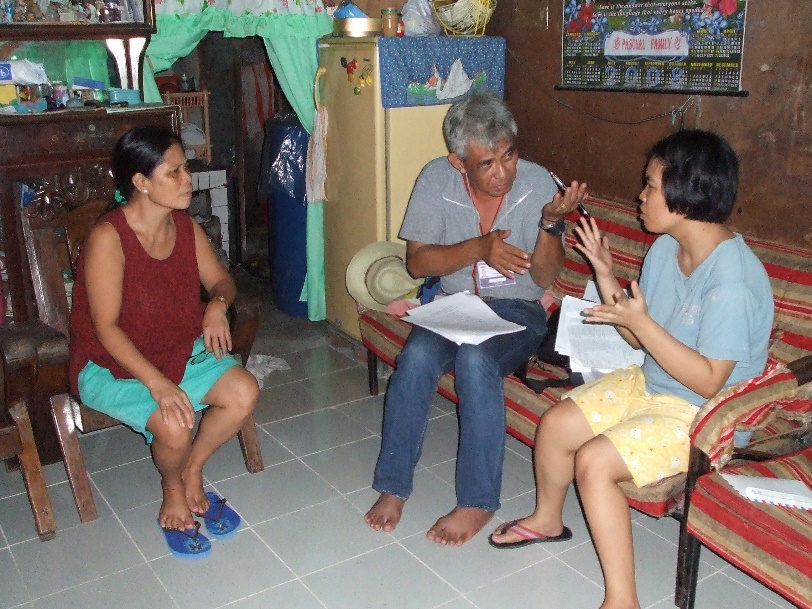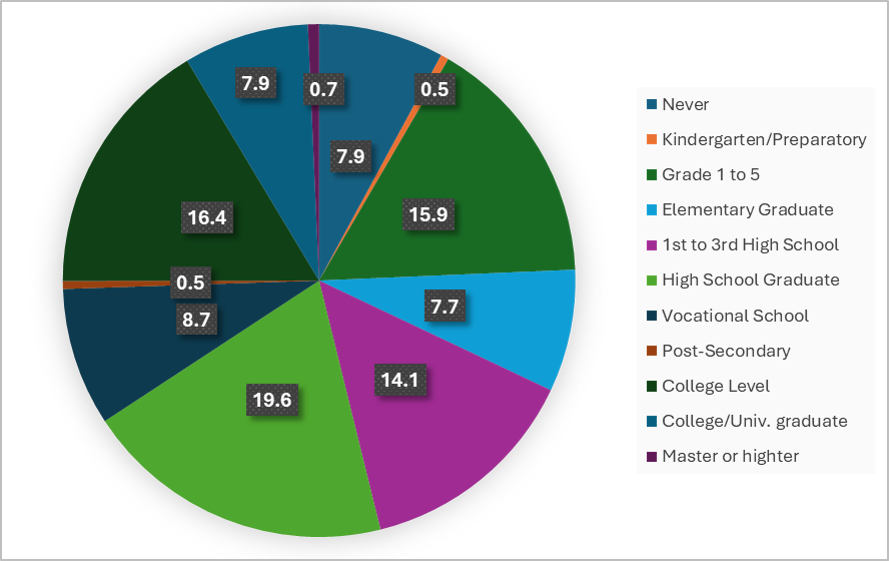IDE Research Columns
Column
Go Further with Evidence-Based Research: Disability and Development

Soya MORI
Institute of Developing Economies, JETRO
January 2025
The Global South confronts numerous pressing issues that must be resolved to alleviate poverty. Such urgent problems include the often-overlooked challenges confronting people with disabilities. Unfortunately, the Sustainable Development Goals (SDGs) do not adequately represent these difficulties, probably because of the paucity of relevant data. Institute of Developing Economies, Japan External Trade Organization (IDE-JETRO) has endeavored to create a data model to bridge this gap. This model will compile comprehensive information on people with disabilities and thus deliver essential data for policymakers.
The “Disability and Development” initiative represents a scholarly endeavor to address the aforementioned challenges using methodologies related to development economics and other social sciences. This initiative aims to elucidate the often invisible struggles of people with disabilities by presenting empirical data that highlight the poverty and structural disadvantages encountered by them in their respective countries. Our survey data on households with persons with disabilities in Metro Manila in the Philippines disclosed that the poverty rate of this segment is four times higher than the general population. Our comparative analysis revealed significant income distribution variations among households with disabilities, influenced by the type of disability as well as the urban-rural divide. Urban households with visually impaired members tended to report the highest incomes, while the earnings of such households in rural areas were significantly lower.
Where Is the Disability Issue Positioned Among the SDGs?
Are we conversant with the circumstances of people with disabilities (PWDs) in developing countries? Extensive research exists on children and women who are considered vulnerable sections of society but the circumstances of PWDs, another underprivileged and marginalized segment, often remain disregarded. The Sustainable Development Goals (SDGs) denote a critical global policy framework. They highlight issues related to gender and children. However, disability issues are notably absent from the 17 primary goals and appear only in more explicit targets that are “specific, measurable objectives whose attainment will contribute in a major way to achieving one or more goals” (UN Co-Chairs of OWG 10th Session 2014). This omission is troubling because approximately 15% of the global population comprises PWDs, of whom a significant proportion reside in developing nations.
PWDs can contribute significantly to the development of their nations. The SDGs emphasize the imperative to “Leave No One Behind.” A third of the world’s impoverished segment lives with disabilities, particularly in developing countries. How well do we apprehend their living conditions through hard data? Are PWDs entirely dependent on family members, or do they earn? These questions are becoming increasingly relevant as PWDs in developing nations assert their rights and the international community contemplates the incorporation of disability into poverty reduction strategies.
Disability-Inclusive Survey
The insufficiency of data on PWDs is a primary reason for the lack of visibility. Numerous NGOs have reported the dire circumstances confronting PWDs. Such case studies are compelling but do not deliver the robust evidence-based research required by policymakers, crucial for the estimation of necessary budgets, and essential for the formulation of effective policies. Disability and Development research was scarce in the first decade of the 21st century. Our IDE-JETRO team endeavored to bridge this gap by presenting a research model in collaboration with the Philippine Institute for Development Studies (PIDS) and Disabled People Organizations (DPOs) in the Philippines. This survey project brought together development economists, statisticians, and DPO leaders.
Careful Sampling
We employed a meticulous process of data sampling. Many existing surveys related to PWDs in developing countries tend to rely on DPO membership lists or snowball sampling methods. Conversely, our survey aimed to produce policy-effective and reliable data apt for budget planning. This objective mandated the accurate representation of the state of PWDs in Metro Manila in the Philippines.
To achieve our study objective, we selected the four cities of Pasay, Valenzuela, Makati, and Quezon City that best reflect the general conditions of Metro Manila according to the income and population distribution data obtained from the national census (The careful sampling way was followed by Reys and Due. 2009). The barangay is the smallest public administrative unit in the Philippines. However, barangay populations vary widely. We coordinated barangay population sizes to create the survey units.
Our survey was conducted by teams that included both PWD leaders and research enumerators to ensure a disability-inclusive approach. This collaboration between PWDs and development specialists underscored the comprehensive and inclusive nature of our survey. United Nations (2011) suggests the importance of this kind of Disability-Inclusive Survey. One of a few good practices of Disability-Inclusive survey in Japan is Kaneko (2012).
PWDs Are Four Times Poorer
This project explores the opportunities and challenges faced by PWDs in developing countries, focusing on the case of the Philippines. The Institute of Developing Economies (IDE) in Japan and PIDS conducted a statistically satisfactorily sampled field survey in Metro Manila in 2008, interviewing around 400 PWDs. The data were analyzed using econometric methods. The survey conducted in four cities in Metro Manila revealed significant disparities in earnings among PWDs. The poverty rate of PWDs was 40.8%, approximately four times higher than the general population (10.4%). This result corroborated NGO reports that many PWDs experience extreme poverty.
Education Barriers
Income disparities also exist among discrete disabilities. The blind in Metro Manila earned Philippine Peso (PHP) 58,315 on average. On the other hand, the deaf averaged an income of PHP13,053 and people with mobility disabilities earned PHP10,460 on average. Blind individuals earn the most in Metro Manila compared to individuals with other disabilities, primarily because the urban environment enabled cash income through services such as mall massages. Conversely, blind individuals earn the least in rural areas according to our companion surveys conducted in Rosario, Batangas, and Cebu Province.

Figure 1. Distribution of Level of Education in Metro Manila
Source: Elaborated with the data from Mori et al. 2015.
Figure 1 illustrates the educational attainment levels of the PWDs in Metro Manila. A significant number of PWD do not even pass elementary school (24.3%). Figure 1 illustrates that many PWD individuals struggle with the barriers to attending schools and attaining access to education even when they are enrolled at schools.
We also used an econometric tool known as the Mincer regression to examine the effects on the incomes of PWDs. We obtained the following results: (1) There is a remarkable education and sex related income disparity among PWDs; (2) we found after controlling for the characteristics of PWDs that female PWDs are likely to earn less than male PWDs. Such a significant income divergence between male and female PWDs is remarkable in the Philippines, where gender-based income differences are generally small. This finding suggests that female PWDs are doubly disadvantaged in their earning abilities.
Our analysis of the reasons underlying the differences in income distribution by disability confirmed that the expected income increase is associated with an additional year of schooling. In addition, better educational attainment correlates with improved economic outcomes for PWDs. Moreover, women with disabilities earn less income than men with disabilities despite the international reputation of the Philippines for instituting progressive women’s advocacy policies.
The book published as a result of this research, Soya Mori, Celia M. Reyes and Tatsufumi Yamagata (eds.), Poverty Reduction of the Disabled: Livelihood of Persons with Disabilities in the Philippines, Routledge, 2015 includes further discussions. The book deliberates on themes such as features of life, livelihood, education, occupation, and policy implications for better lives for PWDs in the Philippines. The survey accords us with a clearer quantitative perspective on PWDs. It is useful for government policy-making; it also allows us to understand the significance of data collection for government and disability organizations.Discussion
Our survey revealed the surprising economic disparity between men and women living with disabilities in the Philippines, a country renowned for its disability rights legislation, the Magna Carta for PWDs, and the Philippine Commission on Women. Despite these institutional frameworks, women with disabilities encounter worse economic conditions than their male counterparts. Women with disabilities in the Philippines are subject to the government policies established for PWDs as well as for women. Interestingly, neither policy can alleviate their more damaging circumstances. This discrepancy prompts further research. Many women leaders with disabilities exist but their efforts have not substantially improved the overall conditions for women with disabilities. We must expand our efforts to develop effective policies to address this issue. This intersectional issue of gender and disability represents a novel focus of our research. The project also examines the positive impact of organizations such as DPOs and highlights how government programs can function in empowering PWDs. It concludes that education, training, DPOs, and institutional support must be harmonized to improve the livelihoods of PWDs, who often remain at the bottom of the income spectrum.
In addition, like other developing countries, the Philippines also displays deficiencies in the educational conditions for children with disabilities. Transportation and health service barriers significantly impede the access of PWDs to education. DPOs are actively addressing these challenges. It is essential to compile superior data for informed policy-making and international assistance. Articles 31 and 32 of the UN Convention on the Rights of Persons with Disabilities also ask for such international cooperation.
Conclusion and Implications
In conclusion, some progress has been made but much work remains to be accomplished to improve the conditions of PWDs in developing countries. We can formulate policies that truly leave no one behind through comprehensive data collection efforts and evidence-based research. The achievement of this goal mandates more international cooperation in research on PWDs. We hope our book will serve as a beneficial model for the research. Our study primarily analyzed and derived implications related to education. Notably, similar types of barriers may exist for PWDs in the educational scenarios of many other developing nations.
References
Kaneko, Y. 2012. “Shougai-Sha no Shunyu Shotoku no Jokyo to Shuro-Shien no Houkou-sei (The Current Situation of Income of PWDs in Japan and the Future Directionality for the Assistance for Their Employment Promotion (in Japanese).” Presentation at an Open Session of READ (Research on Economies and Disability) Project, March 17, 2012 at the University of Tokyo.
Mori, Soya., C. M. Reyes, and T. Yamagata eds. 2015. Poverty Reduction of the Disabled: Livelihood of Persons with Disabilities in the Philippines. UK: Routledge.
Reys, C., and E. Due. 2009. Fighting Poverty with Facts: Community-Based Monitoring Systems. Ottawa: International Development Research Centre.
https://idl-bnc-idrc.dspacedirect.org/server/api/core/bitstreams/96d86334-f4cf-43a5-b8ba-aaffaf9ccb5b/content
United Nations. 2011. “Guidelines and Principles for the Development of Disability Statistics.” New York: UN (The document which explains how to make the Disability-Inclusive Statistics written by the UN following CRPD Article 31 - Statistics and data collection).
United Nations Co-Chairs of OWG 10th Session. 2014. “A Definitional Note on Goals and Targets.” New York: UN (The guidance for the terms for SDGs which was prepared and published for the discussions for SDGs by the UN Open Working Group (OWG) on sustainable development).
https://sustainabledevelopment.un.org/content/documents/7417presentation.pdf, access on 2025/1/14.
* Thumbnail image: The Deaf Interviewer Interviewed with The Deaf Interviewee (A photo taken by Dr. Tatsufumi Yamagata during the field work)
** The views expressed in the columns are those of the author(s) and do not represent the views of IDE or the institutions with which the authors are affiliated.

